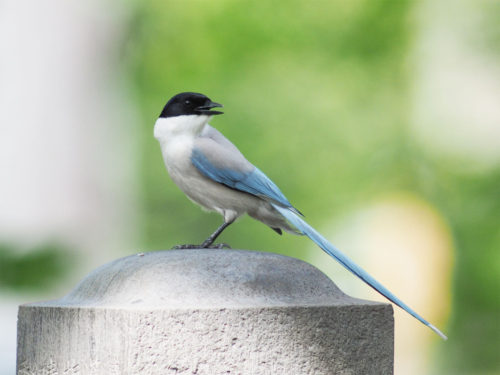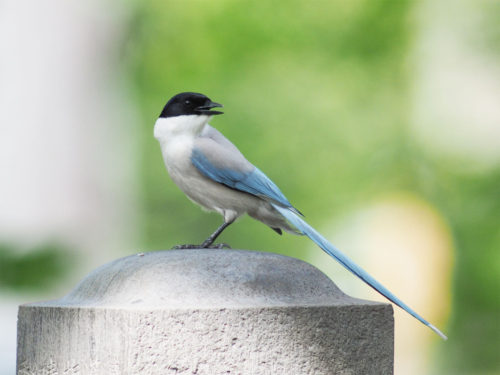ANIMAL: Oriental Azure-Winged Magpie Cyanopica cyana Type of Animal: Corvid Habitat: Mountain gorges, sand dunes with trees, agricultural areas, grassland, woodland, orchards, groves, parks, gardens, coniferous forest, broadleaf forest Location(s): Russia, E. China, Korea, Japan, parts of Mongolia, N. Vietnam Appearance: Glossy black head, white throat, azure-colored wings, light grey/fawn back/underparts. Wings more colorful on adults than juveniles. Chicks have grey head. Juveniles paler than adults w/ stubby tails. Food/Diet: Fruit, berries, insects, seeds, grasses, stems, insect larvae, earthworms, grubs, acorns, olives, refuse, carrion, nuts, spiders, small lizards, small rodents, small birds, small snakes, frogs Status in Wild: Stable Conservation: Breeding in zoos & aviculture Lifestyle: Found in flocks of up to 100 birds. Often breed in colonies of up to 35 families, with each family comprising a monogamous pair w/ up to 4 successive clutches (3-9 young per clutch). Additional Info: Called: Male-Cock Female-Hen Young-Chick Group-Flock/Parliament Weight: 2.24-2.72 oz Gestation: 15 days Height: 1-1.14 ft Body Length: 1-1.14 ft Life Span: 15 years in wild, up to 20 years in captivity Tail Length: 7.4-7.8 in Due to vicious mobbing attacks, only bears, foxes, lynxes, & large eagles catch them successfully. During courtship, male fans tail towards female & bows at her. Then, pair chases each other. Nests made up of 60% moss along w/ small pieces of paper, wool, & hair. Though stable, potential threats include habitat loss, deforestation, pet trade, hunting for feathers, & persecution as crop pests. Closely related to jays, crows & ravens. Sexually mature at 2 years old. Highly vocal, often being heard before seen. Chicks fledge after 2 weeks. Fun Fact(s): They’ve been known to show human-like generosity towards flock mates, especially in terms of providing food. Their voice is a quick fired kwink-kwink-kwink preceded by a karrah. Known to be quite intelligent when it comes to searching/gathering food. Friendly for most of year, they’re quite defensive of nest & have been known to attack humans that venture too close. Chicks have very low mortality rate when nests close to those of Japanese Lesser Sparrowhawk pairs, which help in mobbing attacks of potential predators.

